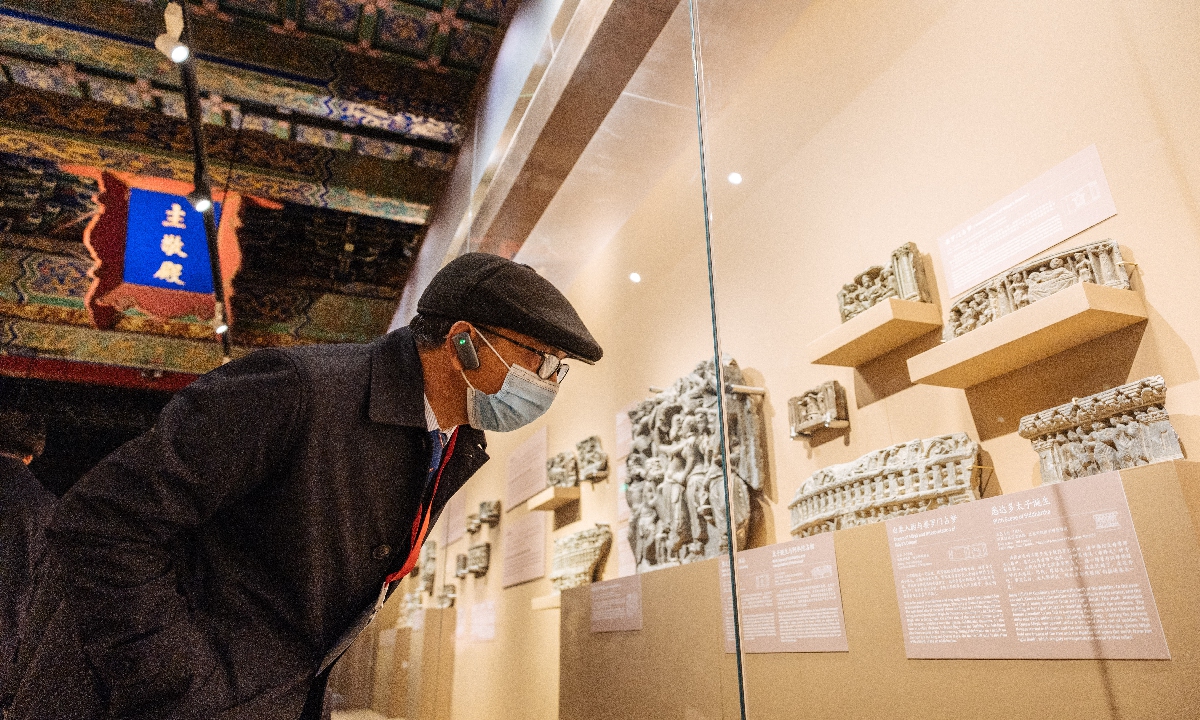
A spectator examines exhibits at the Gandhara Heritage along the Silk Road: A Pakistan-China Joint Exhibition at the Palace Museum in Beijing, on March 15, 2023. Photo: Li Hao/Global Times
The largest exhibition of Gandhara art ever held in China, showcasing the diverse cultures of Pakistan and the long history of China-Pakistani relations, kicked off at the Palace Museum in Beijing on Wednesday, receiving widespread attention at home and abroad.
The
Gandhara Heritage along the Silk Road: A Pakistan-China Joint Exhibition, co-organized by the Palace Museum and the Department of Archaeology and Museums at the National Heritage and Culture Division of Pakistan, aims to promote mutual understanding between China and Pakistan, in particular to make Chinese people aware of the depth and charm of Gandhara culture, according to the Palace Museum.
The exhibition displays 203 artifacts, of which 173 come from seven museums in Pakistan and 30 from the Palace Museum. The exhibits fully demonstrate the artistic charm of Gandhara culture and its far-reaching influence in China and East Asia.
As early as 100 BC, China opened up the Silk Road, which promoted the prosperity of Chinese culture and also built a bridge of friendship between the two ancient civilizations of China and Pakistan, Wang Xudong, director of the Palace Museum, said at the opening ceremony of the exhibition.
Gandhara is the ancient name of a region in northwest Pakistan. Archaeological sites for this culture mainly dot across the southern end of Hindu Kush and Karakorum. According to historical records, between 400 and 630 AD, ancient Chinese monks and pilgrims such as Faxian, Song Yun and Xuanzang visited the area, leaving records of Gandhara's material culture that later became crucial historical sources for the study of the early history of Pakistan.
With active and continuous exchanges and mutual inspiration along the Silk Road, Gandhara showed unparalleled vitality and creativity and had a profound impact on the spread of Asian civilization. According to Wang, Gandhara Buddhist art, which originated in the Kushan Empire, entered central China through the Silk Road via what is today's Northwest China's Xinjiang Uygur Autonomous Region and the Hexi Corridor, promoting the development of early Chinese Buddhist culture and art.
Swat, Kashmir and Gilgit art, influenced by Gandhara art, crossed the western part of Southwest China's Xizang Autonomous Region and entered the Qinghai-Tibet Plateau of China, which provided sustenance for the development of Tibetan Buddhism art after the 10th century, experts noted.
This year marks the 10th anniversary of the Belt and Road Initiative. The Palace Museum, as an important bearer of 5,000 years of Chinese civilization, will further become a cultural meeting place for the exchange and mutual building of civilizations, Wang said.
"We are honored that Pakistan can co-support the exhibition and provide a platform to showcase the intimate relationship between the two countries," he noted.
Preparations for the exhibition started in 2019, but the event itself had to be postponed several times due to the COVID-19 pandemic.
"Because of COVID-19 we couldn't do much for the last three years, now things have started picking up. This is the first exhibition in China that we have done, so we're very proud of that and we hope to do more in the future," Fareena Mazhar, secretary of the National Heritage and Culture Division of Pakistan, told the Global Times, adding that on the basis of this exhibition, extensive cooperation in cultural relic protection and personnel exchanges between China and Pakistan will be carried out, which will contribute more to the friendship between the two countries.
"We are also planning on exchanging scholars from both countries, so they [Chinese scholars] can visit our site and scholars from Pakistan can come and visit China. Maybe they can have some time in the Palace Museum to see all the beautiful things that they have heard and learn more advanced techniques to preserve relics," she noted.




